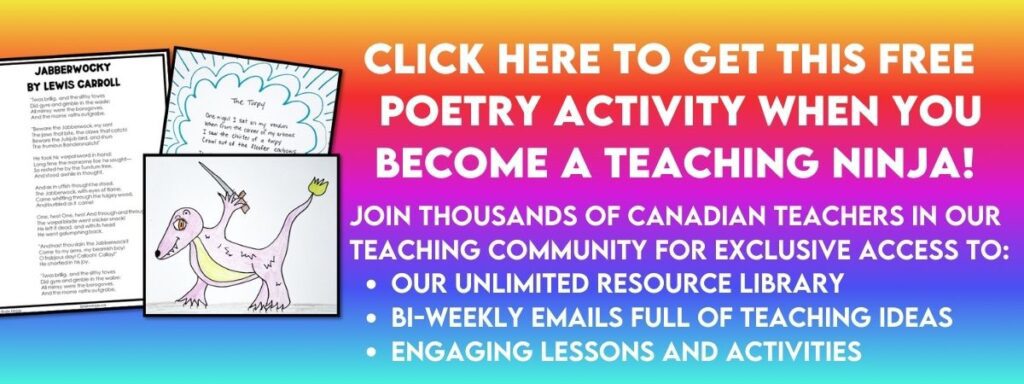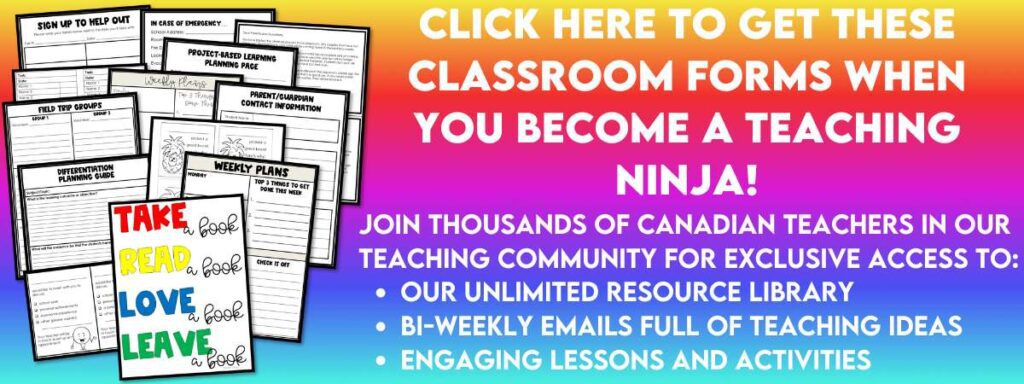
We’re hosting a “Poem in Your Pocket” day as a celebration of completing our poetry unit in Language Arts. It coincides with the National Poem In Your Pocket Day held each year in April. It’s coming up soon! You can join us this year even if you haven’t taught poetry in your classroom yet!
First of all, don’t let the poetry celebration fool you, but we teach poetry all year long. Whether you teach it as a unit, create a theme for a month, or sprinkle it throughout your year, poetry is often one of the best ways to get your students to write because they perceive it as easy (when they have an idea). It’s also a lot of fun.
Most countries celebrate their National Poetry Month in April, though the United Kingdom celebrates their National Poetry Day in October. Each year features a different theme. We encourage you to celebrate all year round!
Here are some of our favourite ways to include poetry in our school year:
Read Poetry
Each student has a poetry book where they collect, print, write and talk about poetry throughout the school year. We encourage students to find poems they like in books, magazines or online and collect them into a “favourites” file. We’ve done this both on paper and as a Google Slides presentation where students could take pictures of their poems, scan in their published work or create slides with their poems on them. When we create a digital version, we’ve printed it off as a book for a year-end gift. We usually add a poem we’ve written for our students as the cover.
Teach poetic language explicitly in language arts class.
Pair read (two friends reading together) or share read (the whole class reading together) poems. This is a great way to build fluency and comprehension with students who struggle with reading or are learning English. Even if these students cannot read the entire poem independently, they can listen to the ebb and flow of the poem.
Explore Poetry
Our school library has hundreds of poetry books and they are usually just sitting there waiting to be read. We’ll bring thirty to forty to our classroom each month. We read it out loud to each other during silent reading — all the time, we love the rhymes!

Examine song lyrics and talk about how they are connected to poetry.
Create anchor charts about poetic language and hang these up in the room.
Annotate poetry. Make a copy of any poem, but print it so the text is as large as it will fit on a page. Colour code the different figurative language found in the poem.
Look at how poets break the rules we learn in grammar. This always seems to get a big buy-in from students because they like the idea of breaking the rules.
Try this free poetry activity. You can find it in our Resource Library or we’ll send it to your inbox when you sign up to receive our emails.
Create Poetry
Write poetry. Allow poetry to be an acceptable written form. We’ve seen poems about historic events taught in social studies, how to grow plants in science and even a Ballad of the Wheel and Axle.
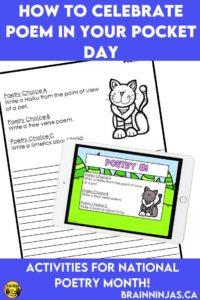
Encourage students to write poetry whenever possible. We use poetry writing prompts woven into our school days to get students writing poetry throughout the year. You can find the Holiday Writing Prompts for Poetry Month in our TPT Store ($USD) and BN Shop ($CAN).
Write poems about topics we are learning in science and social studies as a way to remember information. Students get pretty creative, and it can be lots of fun to say our little rhymes. We even see students mouthing the words during tests which means learning using poetry works!
Experiment with different types of poetry like Black Out Poetry, where students highlight words on a printed page of text, creating a poem. Found Poetry is where you give students a handful of words (they can be from anywhere, such as cut from magazines or printed off the Internet) and they turn it into a poem. Concrete Poetry is always fun as students try to make their poems look like the words in the poems.
Dramatize poems. We find our favourites and then act them out for the younger classes. It can be a lot of fun to sort out costumes or make simple puppets. One student is usually the narrator, while others act out the actions in the poem. You can link several poems together to create a showcase.
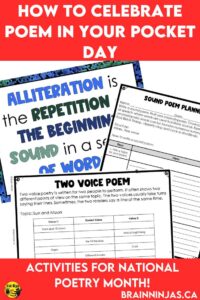
Do a unit of Poetry and Drama Activities where students get to act out poems and different aspects of poetry writing. Our students inspired this unit, and they love it. You can find the Poetry Through Drama Lessons & Activities in our TpT Store ($USD) and BN Shop ($CAN).
If you are looking for more ways to add drama, you should read our blog post: Add Some Drama to Your Classroom.
Celebrate Poetry
Create a “graffiti poetry wall” where students are encouraged to write right on the wall. We put up butcher block paper (you know those big rolls of paper) on the wall (usually double thick so that students who use markers won’t run through the paper). Students are invited to draw, write or create on the wall including writing kind messages about the writing of others.
Memorize a poem or two. We use these poems as our hype-up class rituals. One year it was a chant about being alive in grade five, and another year it was the Beaver Call from Moose Tube on Go Noodle.
Host a poetry fest where each day at lunch while students are eating, we have guests and our own students stand up on our “stage” to perform poetry they have memorized, written or created to perform. This is so much fun, and we’ve even included other classes from our school to take part in.
Display poetry everywhere possible. We hang poems on the door, on the windows, all over desks and on the covers of our books. We’ve done a “Poet Tree” where students write poems on the leaves of a giant tree.
Don’t forget to celebrate Poem in Your Pocket Day!
What is Poem in Your Pocket Day? Well, you can search anywhere online to find the specific day, but generally, in Canada, it is held in April. Students are encouraged to find a poem and keep it in their pockets. Then, throughout the day, ask students to share the poem they have. Keep a poem in your pocket, too, because students will ask you to say it to them.
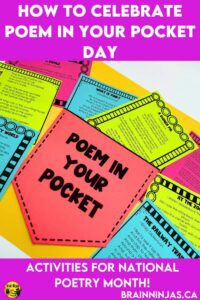
Have students find a poem they enjoy or write their own. There are lots of poems online, in magazines or in books. They can write it down, photocopy it or print it off, but be sure they keep the name of the author so they can give proper credit. Students keep it in their pocket (or some other clever storage solution — one student clipped it into her hair).
It’s even more fun if you involve students from other classes or get teachers on board and it takes very little preparation. In fact, we printed out a few extra poems so students who forgot could still have a poem to share.
We decided to create pockets for our students and got a little carried away, creating an entire resource for teachers like you. We want to help spread a love for poetry. You can find these Poem In Your Pocket Poetry Activities in our TPT Store ($USD) and BN Shop ($CAN). Students from your class and all over your school can get involved with this project.
The best part about an activity like Poem in Your Pocket is that anyone can participate without having to know how to write a poem. Our students who are learning English can find a poem that works for them (even if it’s a little one or just one in their own language).
Poetry is for everyone, and it’s not meant to be taught all in one day.
Why should you be teaching poetry?
Reluctant Writers
For those students who struggle with writing large amounts of text, poetry offers a more slimmed-down approach. It doesn’t seem as daunting to write a Haiku or limerick. Poetry is often a way to get those writers to take a chance on writing. We use writing prompts with our students. You can learn more about how in this post Challenge Your Students with Writing Activities Every Day.
English Language Learners
Syllables, rhythms and patterns are all prominent in poetry, which can help your English Language Learners hear the sounds and how rhyme works. They can learn how certain words flow together, and if they are just beginning to write in English, poems are short, and they can stick to free verse without worrying about how to write. Anything goes in a poem!
We have written entire posts with English Language Learners in mind. Check out How to Add Some Meat to Your Idioms Lessons or How to Have Fun With Homonyms.
Your Creatives
You have those students in your class who could probably write every single thing they write as a poem if you would let them. There are some students that thrive writing poetry and it’s time to let them shine.
Figurative Language
Understanding figurative language in poetry leads to an understanding in all other forms of writing. This improves overall comprehension for students as it teaches them to infer, understand symbolism, and use imagery. Poetry is often a visual experience that helps students learn to visualize as they read.
What are some great poetry books?
You would be surprised if you spent some time in the poetry section of your school or public library. There are hundreds of poetry books published each year. We are constantly adding to our collection. Our students recommend books to us and each other using these Book Recommendation Sticky Notes. You can find the set, along with more classroom forms, in our Resource Library, or we can email it to you when you sign up for our email list.
It’s very difficult to just list a few of our favourite books, but here is a list of a few:
Canadian Poets
- Mabel Murple by Sheree Fitch
- Sleeping Dragons All Around by Sheree Fitch
- Don’t forget to visit Sheree Fitch’s website.
- Noisy Poems for a Busy Day by Robert Heidbreder
- Alligator Pie by Dennis Lee
- Garbage Delight by Dennis Lee
- Lasso the Wind by George Elliott Clarke
- Follow Follow: A Book of Reverso Poems by Marilyn Singer
- The Hockey Song by Stompin’ Tom Connors and Gary Clement
- Boy Soup by Loris Lesynski
- Up Home by Shauntay Grant
- Sweetest Kulu by Celina Kalluk
- Nokum is My Teacher by David Bouchard
Some of Our Silly Ones
- Wet Cement: A Mix of Concrete Poems by Bob Raczka
- Once, I Laughed My Socks Off – Poems for kids (Volume 1) by Steve Attewell
- Dogku by Andrew Clements
- My Life as a Gold Fish and Other Poems by Rachel Rooney
Oldies but Goodies
- Where the Sidewalk Ends by Shel Silverstein
- The Giving Tree by Shel Silverstein
- A Light in the Attic by Shel Silverstein
- It’s Raining Pigs & Noodles by Jack Prelutsky
- A Pizza the Size of the Sun by Jack Prelutsky
- Revolting Rhymes by Roald Dahl
Outside the Box Poetry
- Love that Dog by Sharon Creech
- Hate that Cat by Sharon Creech
- Booked by Kwame Alexander (His books are for a slightly more mature audience, but anything by Kwame Alexander tends to get the boys in the class writing poetry!)
Poems Talking About History
- Freedom Over Me by Ashley Bryan
- Canadian Railroad Trilogy by Gordon Lightfoot and Ian Wallace
Poetry Anthologies
- Kids Pick the Funniest Poems by Bruce Lansky
- Technically It’s Not My Fault by John Grandits
- The Random House Book of Poetry for Children by Jack Prelutsky and Arnold Lobel
- The Llama Who Had No Pajama: 100 Favorite Poems by Mary Ann Hoberman
And don’t forget about listening to poems read by authors. Check out the Children’s Poetry Archive. You should listen to the Poetry4Kids Podcast.
If you are looking for some of our other book lists
- Kindness Books
- Books for Orange Shirt Day
- Remembrance Day
- Christmas Books We Love
- Books for Holi
- Books for Ramadan and Eid
- Lunar New Year
- Cozy Up With Winter Books
- Black History Books
- Books for Social Emotional Learning
- Books with Great LGBTQ+ Characters
- Asian Heritage Month
- Earth Day
- Thanksgiving
- Books For and About Powerful Women
- Books by Indigenous Authors
What are some of your favourite ways to teach poetry? Did we miss it? Leave us a comment so we can add it to our list.
So, what poem will you carry in your pocket?

